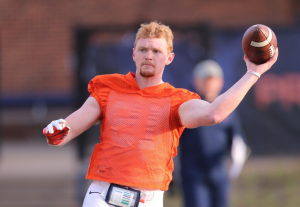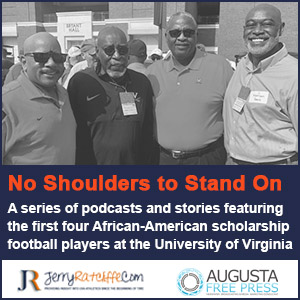QB Armstrong has all the tools, all he needs is experience
By Jerry Ratcliffe

Virginia’s Brennan Armstrong is ready for his chance to start at quarterback in the fall (Photo: UVA Athletics).
Without spring football practice, we’re all going to have to wait in order to see what life without Bryce Perkins will be like.
Spring practice is a time when young quarterbacks earn their oats. It’s a month of growth, a month of development. It’s when Perkins gained confidence and became comfortable after he came to Virginia from Arizona Western Community College, before he became a record-setting Cavalier quarterback.
Life after Perkins will be defined by rising redshirt-sophomore Brennan Armstrong, who served as Perkins’ understudy this past season. Because Perkins was so tough, so durable, we didn’t get to see much of the backup, and that makes some Virginia fans nervous.
Perkins, who appeared on my radio show several weeks ago, said Wahoo fans shouldn’t fret.
“I wouldn’t be worried at all if I were a Virginia fan,” Perkins said from California, where he was preparing for a shot at the NFL. “He’s a great playmaker, he can move. He has a cannon for an arm, a natural gunslinger. He sees the field so well. I would be encouraged because he’s back there.”
Armstrong appeared in seven games last season, half of the Cavaliers’ contests, but didn’t get a lot of action. He completed 75 percent of his passes (15 of 20) for 196 yards and a touchdown (two interceptions). One of those passes went for 44 yards.
During a video conference with Bronco Mendenhall on Thursday, we asked the coach how much missing spring practice will impact Armstrong’s growth, how much last season’s extra practice for the ACC Championship game and the Orange Bowl might have made up for that, and what Bronco liked about his new QB’s game.
“No question [missing an entire spring] prohibits and eliminates a growth opportunity that we won’t be able to recreate,” Mendenhall said. “That will be pushed to the season, which those are unknowns that we would have liked to have known before the season.”
There’s no question that in modern-day football, the quarterback position is disproportionately more important than any other spot on the field.
“We’ll probably have to reconsider what fall camp might look like at that position specifically to try to expedite the timing, knowing there are limitations on what we can do,” the coach said. “There’s no question that will hurt us. No question that will set us back, no question that will make it harder to execute the way we need to, and it puts more pressure and a tighter time frame on all of us.”
With players returning home for the remainder of spring, it will be incumbent upon Armstrong to handle his individual preparation, commitment, resiliency and problem-solving without a coach nearby to correct shortcomings. He will receive instructions from coaches on specific drills that are in compliance with NCAA guidelines, although as Mendenhall cautions, “That is still not the same as spring practice, and nor will it ever be.”
Mendenhall prefers to have those type of kids in his program, the kind that like challenges, that want to take on difficult situations.
Armstrong has shown a willingness to do just that when he’s had to fill in for Perkins for an offensive possession, when the starting QB missed a series to brush off the pain from a jarring tackle.
That was the case two seasons ago when Perkins injured a finger against Louisville. Armstrong came in and was aggressive running the football against the Cardinals, showing lots of moxie. Here’s a look at some of his high school highlights:
He also filled in for Perkins during a portion of last fall’s training camp when Perkins was recuperating from a knee injury.
While he didn’t see a great deal of action last season and will miss the opportunity to develop this spring, there is a bit of a silver lining in the fact that Armstrong got extra practice during Virginia’s preparation for its ACC Championship game against Clemson, and for the Orange Bowl contest versus Florida.
“Absolutely,” Mendenhall said. “Without those, I would have felt much different. We basically got a modified spring in that context.”
The coach said Armstrong was given lots of work, lots of repetition during both those preparations and, of course, last training camp.
There is a lot to like about Armstrong’s game and personality as far as Mendenhall is concerned. He likes his mindset, something he views as most important.
“Brennan is a player that thinks he can make every play,” Mendenhall said. “He’s very confident. He’s very, very competitive. He has high standards for himself.”
There are some qualities about Armstrong’s game that automatically separate him from most quarterbacks.
“He’s actually much better when he’s playing the game than he is in the film room or even in walkthrough,” Mendenhall said. “He’s one of those players that, under duress, seems to have the game slow down rather than speed up for him.”
Given the choice, Mendenhall prefers that profile. He’s had quarterbacks in the past that were great in the classroom and in walkthroughs, but when they were put under game pressure, they weren’t nearly as strong.
“Brennan is the other way,” the coach said.
Mendenhall pointed out that Armstrong is elusive but not dynamic as a runner, that he’s tough and physical and falls forward to move the chains. Then there’s another special quality.
“He’s just a player that seems to win and make players around him better, but there’s also an edge to his personality where I think the team will take on a little bit more of a physical presence, maybe a combative presence and maybe a little more edgier or competitive presence as teams do in relation to a quarterback,” Mendenhall said.
With endorsements from Mendenhall and Perkins, it would seem that all Armstrong needs is more time to develop and grow. If football remains shut down for an extended period of time, the kid will have to do that largely on his own.
If he’s the type of leader he appears to be, Armstrong will be as ready as humanly possible under the circumstances. Remember, under duress, he’s the guy who thrives under pressure. That’s what separates good quarterbacks from mediocre ones.








